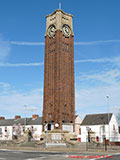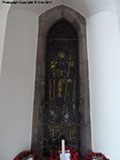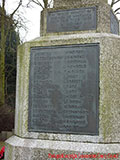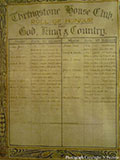Private Herbert Freeman, 240806
- Batt - 1/5
- Unit - Leicestershire Regiment
- Section -
- Date of Birth -
- Died - 11/10/1918
- Age -
Add to this record?
If you have photographs, documents or information that can contribute to this record, you can upload here
ContributeSource: Michael Doyle Their Name Liveth For Evermore: The Great War Roll of Honour for Leicestershire and Rutland. The War Diary for today records. BOIS DE RIQUERVAL. 05.30. ZERO hour, D Coy (HAWLEY) with a left flank platoon (DUNLOP) moved along main road to REGNICOURT, closely followed by C Coy (BANWELL). A Coy (EDWARDES) advanced towards Chateau at south corner of the BOIS, but were at once met with very heavy machine gun fire from the right flank and front and dug in, ½ at cross roads, and ½ in hedge 50 yards east of road. B Coy advanced towards centre of wood and also became split up ½ to dig in under very heavy fire on face of hill, and ½ to dig in near FME DE RIQUERVAL. Battn HQ reached wood edge 100 yards north of Chateau and established a post there with enemy machine gun post on both flanks. Lt. S. COSGROVE commanding B Coy severely wounded. 08.00. D Coy (HAWLEY) reported within 800 yards of REGNICOURT, came under very heavy fire. Ditches along road side enfiladed and 2 Sergeants and 10 men killed. Consequently decided further advance impossible. C Coy (BANWELL) moved south to try to get touch with remainder of Battn but failed as they were not up. C and D Coy’s therefore formed a line through the wood north and south about 750 yards west of the final objective.08.30. Battn HQ party reinforced slightly now consisted of Commanding Officer, Adjutant and Lt. ASHDOWN with 1 French interpreter M. LETU, 12 French soldiers, 1 Lewis Gun team of the 4th Battn LEICESTERSHIRE REGT, and 1 platoon of A Coy collected from hedge where they were dug in. 10.00. Mixed platoon, English and French under Adjutant attacked and captured Chateau, taking one wounded German on the way. Remainder of A Coy brought up to consolidate. 10.45. Enemy recaptured RETHUIL FARM from the French and completely overlooked the Chateau. 11.00. Enemy covering his advance with very heavy machine gun fire from their front retook the Chateau capturing some of A Coy. The Medical Officer Captain W. B. JACK, ROYAL ARMY MEDICAL CORPS killed whilst attending the wounded with great courage. 2 Coy’s of the 5th Battn SOUTH STAFFORDSHIRE REGT relieved C and D Coy’s. Later marched back to billets in FRESNOY LE GRAND. 11.15. M. LETU sent off to try and arrange French co-operation with a view to attacking Chateau again. This gentleman showed throughout the day the most praiseworthy courage and initiative combined with an entire disregard of danger. 12.30. 2 Coy’s of the 5th Battn SOUTH STAFFORDSHIRE REGT occupied corner of wood, securing left flank of Battn HQ post, right flank still somewhat insecure. 13.45. 1 of the above Coy’s was withdrawn to make new attack which never materialised. Remaining Coy too weak to hold corner of wood withdrew to a line of hedge across the valley 60 yards east of main road. Lt. A. M. EDWARDES (Commanding A Coy) wounded. 16.30. Battn HQ and 1 platoon of A Coy now completely isolated and enfiladed by enemy’s machine guns on both flanks. Position was hopeless and several casualties occurred. Battn HQ therefore withdrew to line left by Coy of the 5th Battn SOUTH STAFFORDSHIRE REGT. 17.15. Enemy seeing attack developing on left of French front opened tremendous bombardment. Gas and high explosive shells of all calibres were fired. Heaviest barrage was on position occupied by Battn HQ and A Coy, valley soon full of gas. 18.00. New positions sited on the side of road on east line, occupied and dug. 19.00. Battn relieved by 5th Battn SOUTH STAFFORDSHIRE REGT. 19.30. On relief Battn marched back to billets in FRESNOY LE GRAND. 20.45. All in billets, tired out. Battn strength 10 officers, 230 fighting.
Source: Leicestershire War Memorials Project. Coalville Times article - Friday November 15th, 1918
LOCAL CASUALTIES
Mrs Freeman, of Hermitage Road, Whitwick, has received news that her son, Private Herbert Freeman, of the Leicestershire Regiment, has been killed in action. He was 22 years of age, and formerly worked at the Whitwick Colliery. A brother of the deceased soldier, Pte. R. Freeman, also of the Leicesters, has been missing for over 12 months.
Coalville Times article - Friday December 20th, 1918
WHITWICK BROTHERS KILLED
Private Herbert Freeman, aged 22, of the Leicesters, is reported to have been killed in action in France on October 11th, and Private Richard Freeman, Leicesters, reported missing on May 3rd, 1917, is now presumed killed. They were the sons of Mrs Freeman, of 92, Hermitage Road, Whitwick, who has two other sons who have been badly wounded.
Coalville Times article - Friday May 21st 1920
THRINGSTONE WAR MEMORIAL
UNVEILED BY COL. BOOTH AT THE PARISH CHURCH
A beautiful stained-glass window has been placed in St. Andrew’s Church, Thringstone, in memory of men from the parish who fell in the war, together with a brass tablet bearing all the names, and the unveiling was performed by Col. T. Booth at a special service last Sunday afternoon, when there was a crowded congregation, which included many relatives of the deceased soldiers.
The service was impressively conducted by the Vicar (the Rev. C. Shrewsbury) and opened with the singing of the hymn, “There is a Land of pure Delight.” Other hymns sung were, “O God our help in ages past,” “The Saints of God,” and “For all the Saints,” also the psalm, “The Lord is my Shepherd.”
The window, which faces the church entrance, depicts St. Alban, the first British martyr to die for the Christian faith, and inscribed, “Christ’s faithful soldier and servant unto his life’s end.”
The tablet by the side of the window bears the inscription, “To the greater glory of God, and in memory of the following who from this parish and congregation have given their lives for their country in the great war 1914 – 1919, this window is dedicated by the congregation and parishioners of St. Andrew’s.”
Here are 27 names, as follows:
1914
Pte. T. Jones, Durham Light Infantry.
1915
Pte. E. Hall, Leicestershire
Corp’l W. E. Moore, R.G.A.
Pte. I. Hall, Leicestershire
1916
Pte. E. Howe, Leicestershire
Sapper E. Robinson, Royal Engineers
Pte. L. Whitmore, Leicestershire
Pte. T. Squires, Leicestershire
Pte. M. Grainger, Leicestershire
1917
Pte. F. B. Bowler, Royal Dublin Fusiliers
Pte. R. Freeman, Leicestershire
Sapper H. Briers, Royal Engineers
A. J. Turner, telegraphist, Royal Naval Volunteer Reserve
Pte. J. Squires, Leicestershire
Pte. L. Haywood, Scottish Rifles
Corp’l W. Sykes, Leicestershire
Pte. T. Bailey, Royal Scots
1918
Corp’l J. Bancroft, Leicestershire
Rfn. G. W. W. Howe, Rifle Brigade
Pte. J. Gee, York and Lancaster
2nd Lieut. T. F. McCarthy, Loyal North Lancashire
Pte. S. R. Dring, Leicestershire
J. T. Fortnam, Able Seaman, Royal Naval Division
L.-Corp’l A. Griffin, Sherwood Foresters
Pte. J. Morley, Suffolk
Pte. H. Freeman, Leicestershire
Pte. H. Lakin, Leicestershire
At the foot appear the words: “Greater love hath no man than this, that a man lay down his life for his friends.”
Having unveiled the memorial, Col. Booth proceeded to the other end of the church and from the chancel steps addressed the congregation as follows:
“My friends, I have been entrusted with the very solemn, but to me, the very proud duty, of coming here to address you, the members of this congregation on the subject of the memorial, that beautiful brass tablet which I have just had the honour to unveil, and I can assure you all that I am fully alive to the responsibility which that has involved upon me, and I am also very appreciative of the honour which it has imposed upon me. I am sure that as you heard those names read out, you could not fail to have been impressed, as I was, with the fact that these precious lives came from every class and from all ranks. What you may not have realised altogether is the width and scope of their sacrifice. I will try to explain what I mean. Reading out those names, I first find mention of men who went out at the start, in 1914, to help to stem the first wild onslaught of the Germans before we were ready; when everything was unprepared. Think of that. Then we pass on to other names of men who gave their lives in 1915, in those dull days in the trenches, when everything seemed dark, and when we appeared to be hammering our heads against a stone wall. Then I find more names in 1916, men who died in the great Battle of the Somme, which lasted for many weeks, but in which their services were rewarded by the first ray of hope which seemed to come to the nation. Then more names I find in 1917, men who took part in those hammering blows which we may regard as the period during which the war reached its height, when the storm seemed to be at its worst. Then in those terrible days in the early spring of 1918, I find more names, when the nation strained well-nigh to breaking point in her brave endeavour to stave off the last despairing effort of the Germans to overwhelm us on the soil of France. Lastly, and to me the most pathetic of all, are some few names of men who fell just as the dawn was breaking, a few days before the Armistice. Well, I have given a brief account of how those names covered that scope I spoke of at first. What then do we owe these men? I do not know whether you, or I, or anybody can yet appreciate the magnitude of that debt, but certain it is, we can never repay. What are we to do then – what must we do? Well, I think we must see to it that these men are never forgotten; that their names are never forgotten. This beautiful brass tablet and memorial window are the proof we intend to give that they shall not be forgotten. I think we must do more than this; we must see that we explain to the new generation that is coming on – explain to them what this tablet means; show them the names, and as they get older and more able to understand, explain to them what it stands for, what we really owe to these men; that we owe to them the peaceful possession of our houses, the freedom of the countryside to-day, the honour of our women and the safety of our little children. I think that is the duty for us in the future, and they will carry it on long after we are no more. Then, finally, I want to say a word to the members of this congregation who are relatives of the fallen. I know that nothing I can say is any real comfort; nothing that anybody can say is of any real comfort; but it may afford you some consolation to know that we, your fellow countrymen, are determined that the names of those beloved ones are not forgotten, and that brass tablet and window stand for all time as a witness to the noble and unselfish example of those brave souls, and I hope when you leave this church after this beautiful service, that you will feel as I do, and as all this congregation do I am sure, that their sacrifice has not been in vain.”
After the Benediction, the service closed with the singing of the National Anthem.
Research undertaken and submitted by Andy Murby 30/6/2018
- Conflict - World War I
- Cause of death - KILLED IN ACTION
- Burial Place - Iv A 32, Busigny Communal Cemetery Extension
- Other Memorials - Coalville War Memorial Clock Tower
- Unit - Leicestershire Regiment
- Cause of death - KILLED IN ACTION
- Burial Commemoration - Busigny Com. Cem. Ext., France
- Enlisted - Coalville, Leics
- Place of Residence - Thringstone, Leicestershire, England
- Memorial - ST. JOHN THE BAPTIST CHYRD. MEM., WHITWICK, LEICS
- Memorial - CLOCK TOWER MEM., COALVILLE, LEICS
- Memorial - ST. ANDREW'S CHURCH, THRINGSTONE, LEICS
- Memorial - COUNCIL OFFICE MEM., COALVILLE, LEICS




